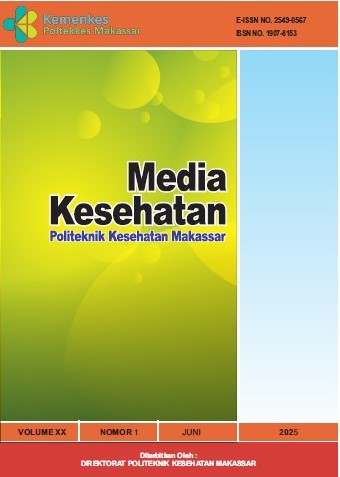Predisposing Factors, Subgroup Classification, Biomarkers, and Mechanisms for Preventing Obesity: A Literature Review
DOI:
https://doi.org/10.32382/medkes.v20i1.1414Keywords:
Predisposition, subgroups, biomarkers, prevention, obesityAbstract
Obesity has emerged as a critical global public health challenge, driven by multifactorial predisposing elements such as sociodemographics, behavior, genetics, and obesogenic environmental factors. This systematic literature review synthesizes evidence on obesity subgroups (e.g., metabolically healthy obesity [MHO], metabolically unhealthy obesity [MUO]), biomarkers (microRNA, adipokines, oxidative stress markers, gut microbiota, and lipid accumulation product index), and prevention strategies. A systematic search of the PubMed, Scopus, and Web of Science databases (2010–2023) identified peer-reviewed studies addressing the etiology, classification, and interventions for obesity. Key findings highlight the interaction between early-life nutritional deficiencies and subsequent metabolic dysregulation, the role of visceral adipose tissue (VAT) in refining the obesity phenotype, and the diagnostic potential of biomarkers such as miR-222 and leptin. Prevention strategies, including school-based nutrition education, taxes on ultra-processed foods, and bariatric surgery for severe cases, demonstrate varying efficacy across populations. This review emphasizes the need for a multidimensional approach tailored to regional contexts, particularly in low- and middle-income countries where the dual burden of malnutrition persists. By integrating evidence of genetic-environmental interactions and new biomarkers, this research provides actionable insights for policymakers and health practitioners to reduce the growing burden of obesity.
Keywords: predisposing factors, subgroup classification, biomarkers, prevention mechanisms, obesity
References
Shukla A, Kumar K, Singh A. Association between obesity and selected morbidities: A study of BRICS countries. PLoS One; 9 : e94433, 2014.
Cabrera-Fuentes HA, Alba-Alba C, Aragones J, Bernhagen J, Boisvert WA, Bøtker HE, et al. Meeting report from the 2nd International Symposium on New Frontiers in Cardiovascular Research. Protecting the cardiovascular system from ischemia: Between bench and bedside. Basic Res Cardiol; 111 : 7, 2016.
Bray GA. Evaluation of obesity. Who are the obese? Postgrad Med; 114 : 19-27, 38, 2003.
Romero-Corral A, Somers VK, Sierra-Johnson J, Thomas RJ, Collazo-Clavell ML, Korinek J, et al. Accuracy of body mass index in diagnosing obesity in the adult general population. Int J Obes (Lond); 32 : 959-66. 2008.
Purnamasari D, Badarsono S, Moersadik N, Sukardji K, Tahapary DL. Identification, evaluation and treatment of overweight and obesity in adults: Clinical practice guidelines of the obesity clinic, Wellness Cluster Cipto Mangunkusumo Hospital, Jakarta, Indonesia. JAFES; 26 : 117-21, 2011
Álvarez-Castro P, Sangiao-Alvarellos S, Brandón-Sandá I, Cordido F. [Endocrine function in obesity]. Endocrinol Nutr Vol 58 : 422-32, 2011.
Muñoz Yáñez C, García Vargas GG, Pérez-Morales R. Monogenic, polygenic and multifactorial obesity in children: Genetic and environmental factors. Austin J Nutr Metab 2017; 4 : 1052.
G. Baffy, “Sarcopenic obesity in liver cancer: it is SO complicated,” HepatoBiliary Surgery and Nutrition, vol. 8, no. 5, pp. 560–562, 2019.
United Nations Children’s Fund, Strategy for Improved Nutrition of Children and Women in Developing Countries UNICEF, United Nations Children’s Fund, New York, NY,USA, 1990.
N.D.Ford,S.A.Patel,andK.M.V.Narayan,“Obesityinlow-and middle-income countries: burden, drivers, and emerging challenges,” Annual Review of Public Health, vol. 38, no. 1, pp. 145–164, 2017.
G. M. Al Kibria, K. Swasey, M. Z. Hasan, A. Sharmeen, and B. Day, “Prevalence and factors associated with underweight, overweight and obesity among women of reproductive age in India,”GlobalHealthResearchPolicy,vol.4,no.1,p.24,2019.
P.N.O.Addo,K.M.Nyarko,S.O.Sackey,P.Akweongo,andB.Sarfo,“Prevalenceofobesityandoverweightandassociated factors among financial institution workers in Accra Metropolis,Ghana:acrosssectionalstudy,”BMCResearchNotes, vol. 8, no. 1, 2015.
J.Baalwa,B.B.Byarugaba, E.K.Kabagambe,andA.MOtim, “Prevalence of overweight and obesity in young adults in Uganda,” AfricanHealthSciences, vol.10, no. 4, pp. 367–373, 2010.
J. Narciso, A. J. Silva, V. Rodrigues et al., “Behavioral, contextual and biological factors associated with obesity during adolescence: a systematic review,” PLoS One, vol. 14, no. 4, Article ID e0214941, 2019.
P. C. d. Santos, K. S. d. Silva, J. A. d. Silva et al., “Change in overweight and obesity over a decade according to socio demographic factors in Brazilian adolescents,” Ciˆencia & Sa´ ude Coletiva, vol. 24, no. 9, pp. 3335–3344, 2019.
M. Firouzbakht, M. E. Riahi, M. Hajian-Tilaki et al., “Relationship of social capital with overweight and obesity among female health care workers,” Caspian Journal of Internal Medicine, vol. 10, no. 3, pp. 281–288, 2019.
S. Al-Lahham, N. Jaradat, M. Altamimi et al., “Prevalence of underweight, overweight and obesity among Palestinian school-age children and the associated risk factors: a cross sectional study,” BMCPediatrics, vol. 19, no. 1, p. 483, 2019.
T. Adom, A. P. Kengne, A. De Villiers, and T. Puoane, “Prevalence of overweight and obesity among African primary schoollearners: a systematicreviewand meta-analysis,” Obesity Science & Practice, vol. 5, no. 5, pp. 487–502, 2019.
I. J. Na, “Proceedings of the Bjorntorp Symposium on Stress, Obesity, and Metabolic Syndrome, a satellite symposium to the 39th Annual Scientific Meeting of the European Society of ClinicalInvestigation.April9-10,2005.Athens,Greece,”Annals of the New York Academy of Sciences,vol.1083,pp.1–344,2006.
L. Hu, X. Huang, C. You et al., “Prevalence of overweight, obesity, abdominal obesity and obesity-related risk factors in southern China,” PLoS One, vol. 12, no. 9, Article IDE e0183934, 2017.
B. M. Popkin, C. Corvalan, and L. M. Grummer-Strawn, “Dynamics of the double burden of malnutrition and the changing nutrition reality,” The Lancet, vol. 395, no. 10217, pp. 65–74, 2020.
R. Al-Raddadi, A. U. Bahijri, H. A. Jambi, G. Ferns, and J. Tuomilehto, “The prevalence of obesity and overweight, associateddemographicandlifestylefactors,andhealthstatus n the adult population of Jeddah, Saudi Arabia,” Therapeutic Advances in Chronic Disease, vol. 10, 2019.
H. Y. Berhane, M. Jirstr¨ om, S. Abdelmenan et al., “Social stratification, diet diversity and malnutrition among preschoolers: a survey of Addis Ababa, Ethiopia,” Nutrients, vol. 12, no. 3, p. 712, 2020.
A. Auguste, D. Julien, M. Gwenn, C. Barul,J.-B. Richard, and D. Luce, “Social distribution of tobacco smoking, alcohol drinking andobesity in the French WestIndies,”BMCPublic Health, vol. 19, no. 1, p. 1424, 2019.
J.K.Ganle,P.P.Boakye,andL.Baatiema,“Childhoodobesity inurbanGhana:evidencefromacross-sectionalsurveyofin- school children aged 5-16 years,” BMCPublicHealth, vol.19, no. 1, p. 1561, 2019.
A. Hruby, J. E. Manson, L. Qi et al., “Determinants and consequences of obesity,” AmericanJournalofPublicHealth, vol. 106, no. 9, pp. 1656–1662, 2016.
S. J. Yoon, H. J. Kim, and M. Doo, “Association between perceived stress, alcohol consumption levels and obesity in Koreans,” Asia Pacific Journal of Clinical Nutrition, vol. 25, no. 2, pp. 316–325, 2016
F. Gokosmanoglu, H. Cengiz, C. Varim, S. Yaylaci, A. Nalbant, and C. Karacaer, “The prevalence of obesity and the factors affecting obesity in the students of secondary education,” International Journal of Research in Medical Sciences, vol. 7, no. 8, pp. 2989–2994, 2019.
H. Sagbo, D. K. Ekouevi, D. T. Ranjandriarison et al., “Prevalence and factors associated with overweight and obesity among children from primary schools in urban areas of Lom´e, Togo,” Public Health Nutrition, vol. 21, no. 6, pp. 1048–1056, 2018.
C. Ngaruiya, A. Hayward, L. Post, and H. Mowafi, “Obesity as a form of malnutrition: over-nutrition on the Uganda “malnutrition”agenda,”PanAfricanMedicalJournal,vol.28,no.49,2017
W. E. Barrington and S. A. A. Beresford, “Eating occasions, obesityandrelatedbehaviorsinworkingadults:doesitmatter when you snack?” Nutrients, vol. 11, no. 10, p. 2320, 2019.
D. M. Golshevsky, C. Magnussen, M. Juonala, K.-T. Kao, B. E. Harcourt, and M. A. Sabin, “Time spent watching television impacts on body mass index in youth with obesity but only in those with shortest sleep duration,” Journal of Paediatrics and Child Health, 2019.
C. Andonian, F. Langer, J. Beckmann et al., “Overweight and obesity: an emerging problem in patients with congenital heart disease,” CardiovascularDiagnosisandTherapy, vol. 9, no. S2, pp. S360–S368, 2019.
E. E. Cinteza and M. Cintez, “Biomarkers in obesity,” Revista Romˆan˘ adeMedicin˘ adeLaborator,vol.26,no.3,pp.353–358, 2018.
E. S. van der Valk, M. Savas, and E. F. C. van Rossum, “Stress and obesity: are there more susceptible individuals?” Current Obesity Reports, vol. 7, no. 2, pp. 193–203, 2018.
N. Rasheed, “Stress-associated eating leads to obesity,” In-ternationalJournalofHealthSciences(Qassim), vol.11, no. 2, pp. 1-2, 2017.
I. Boniecka, H. Wile´ nska, A. Jeznach-Steinhagen, A. Czerwonogrodzka-Senczyna, M. Sekuła, and K. Pa´snik, “Stressas a factor contributing to obesityin patients qualified forbariatricsurgery—studiesinaselectedgroupofpatients(a pilot study),” Videosurgery and Other Miniinvasive Techniques, vol. 1, no. 1, pp. 60–67, 2017.
E. G. Seay, G. Mulholland, and R. C. Dedhia, “Upper airway surgery to rescue the “untitratable” patient with OSA and obesity,” Journal of Clinical Sleep Medicine, vol. 16, no. 1, pp. 149–151, 2019.
E. Ferris and C. Gregg, “Parallel accelerated evolution in distanthibernatorsrevealscandidateciselementsandgenetic circuits regulating mammalian obesity,” CellReports, vol. 29, no. 9, pp. 2608.e4–2620.e4, 2019.
H.ChoquetandD.Meyre,“Geneticsofobesity:whathavewe learned?” CurrentGenomics, vol.12, no. 3, pp.169–179, 2011.
H. Chomba, H. D. Martin, and J. Kimywe, “Prevalence and predictors of obesity among 7- to 17-year-old schoolchildren in Urban Arusha, Tanzania,” Journal of Nutrition and Metabolism, vol. 2019, Article ID 3106597, 11 pages, 2019.
C. Baratin, E. Beune, D. van Schalkwijk et al., “Differential associations between psychosocial stress and obesity among ghanaians in Europe and in Ghana: findings from the RODAM study,” Social Psychiatry and Psychiatric Epidemiology, vol. 55, no. 1, pp. 45–56, 2019.
A. Karki, A. Shrestha, and N. Subedi, “Prevalence and associated factors of childhood overweight/obesity among primary school children in urban nepal,” BMCPublicHealth, vol. 19, no. 1, 2019.
A.D.Lorenzo,“New obesity classification criteria as a tool for bariatric surgery indication,” World Journal of Gastroenterology, vol. 22, no. 2, pp. 681–703, 2016.
Kjaer IG, Kolle E, Hansen BH, Anderssen SA, Torstveit MK. Obesity prevalence in Norwegian adults assessed by body mass index, waist circumference and fat mass percentage. Clin Obes; 5 : 211-8, 2015.
Phillips CM, Perry IJ. Does inflammation determine metabolic health status in obese and nonobese adults? J Clin Endocrinol Metab; 98 : E1610-9, 2013.
Nachabé R, van der Hoorn JW, van de Molengraaf R, Lamerichs R, Pikkemaat J, Sio CF, et al. Validation of interventional fiber optic spectroscopy with MR spectroscopy, MAS-NMR spectroscopy, high-performance thin-layer chromatography, and histopathology for accurate hepatic fat quantification. Invest Radiol; 47 : 209-16, 2012.
Verma SK, Nagashima K, Yaligar J, Michael N, Lee SS, Xianfeng T, et al. Differentiating brown and white adipose tissues by high-resolution diffusion NMR spectroscopy. J Lipid Res; 58 : 289-98, 2017.
Xia L, Dong F, Gong H, Xu G, Wang K, Liu F, et al. Association between indices of body composition and abnormal metabolic phenotype in normal-weight chinese adults. Int J Environ Res Public Health; 14. pii: E391, 2017.
Wildman RP, Muntner P, Reynolds K, McGinn AP, Rajpathak S, Wylie-Rosett J, et al. The obese without cardiometabolic risk factor clustering and the normal weight with cardiometabolic risk factor clustering: Prevalence and correlates of 2 phenotypes among the US population (NHANES 1999-2004). Arch Intern Med; 168 : 1617-24, 2008.
M. Oses, J. M Sanchez, M. P. Portillo, C. M. Aguilera, and I.Labayen,“Circulating miRNAs as biomarkers of obesity and obesity-associated comorbidities in children and adolescents: a systematic review,” Nutrients, vol.11, no.12, p. 2890, 2019.
K. Aleksandrova, D. Mozaffarian, and T. Pischon, “Addressing the perfect storm: biomarkers in obesity and pathophysiology ofcardiometabolic risk,” Clinical Chemistry, vol. 64, no. 1, pp. 142–153, 2018.
M. N. Meza and J. A. B. Carrillo, “Biomarkers, obesity, and cardiovascular diseases,” Role of Biomarkers in Medicine, Intechopen, London, UK, 2016.
A. Ortiz-Dosal, P. Rodil-Garc´ ıa, and L. A. Salazar-Olivo, “Circulating microRNAs in human obesity: a systematic review,” Biomarkers, vol. 24, no. 6, pp. 499–509, 2019.
S. Musaad and E. N. Haynes, “Biomarkers of obesity and subsequent cardiovascular events,” Epidemiologic Reviews,vol. 29, no. 1, pp. 98–114, 2007.
H. Xue, X. Cheng, P. Jia, and Y. Wang, “Road network intersection density and childhood obesity risk in the US: a national longitudinal study,” PublicHealth, vol. 178, pp. 31–37, 2019.
E. Erdal and M. Inanir, “Platelet-to-lymphocyte ratio (PLR) andPlateletcrit(PCT)inyoungpatientswithmorbidobesity,” Revista da Associação M´edica Brasileira, vol. 65, no. 9, pp. 1182–1187, 2019.
F. Cembranel, J. P. Wagner, W. C Giehl et al., “Obesity and 25(OH)D serum concentration are more important than vitamin D intake for changes in nutritional status indicators : a population-based longitudinal study in a state capital city in southern Brazil,” Nutrients, vol. 11, no. 10, p. 2366, 2019.
S. Rauschert, O. Uhl, B. Koletzko, and C. Hellmuth, “Metabolomic biomarkers for obesity in humans: a short review,” Annals of Nutrition and Metabolism, vol. 64, no. 3-4, pp. 314–324, 2014.
E. Abiola and M. M. Mello, “Multilevel legal approaches to obesityprevention:aconceptualandmethodologicaltoolkit,” PLoS One, vol. 14, no. 10, Article ID e0220971, 2019
T.M.Barber,H.Petra,O.Martin,andS.Franks,“Obesity and polycystic ovary syndrome : implications for pathogenesis and novel management strategies,” Clinical Medicine Insights: Reproductive Health, vol. 13, 2019.
B. Armenta-Guirado, T. Mart´ ınez-Contreras, M. C. Candia Plata et al., “Effectiveness of the diabetes prevention program for obesity treatment in real world clinical practice in a middle-income country in Latin America,” Nutrients, vol.11,no. 10, p. 2324, 2019.
N.H.M.Bartelink,P.vanAssema,S.P.J.Kremersetal.,“Can the healthy primary school of the future offer perspective in the ongoing obesity epidemic in young children? A Dutch quasi-experimental study,” BMJ Open, vol. 9, no. 10, Article ID e030676, 2019.
N. S. Bayoumi, E. Helzner, A. Afable, M. A. Joseph, and S. Dhuper, “A real-world evaluation of a tertiary care childhood obesity intervention to reduce metabolic risk in a hard-to-reach urban population,” BMC Pediatrics, vol. 19, no. 1, p. 378, 2019.
C. Flannery, M. Fredrix, E. K. Olander, F. M. McAuliffe, M. Byrne, and P. M. Kearney, “Effectiveness of physical activity interventions for overweight and obesity during preg-nancy:a systematic review of the content of behaviour change interventions,” International Journal of Behavioral Nutrition and Physical Activity, vol. 16, no. 1, p. 97, 2019.
D. B. Bookwalter, B. Porter, I. G. Jacobson et al., “Healthy behaviors and incidence of overweight and obesity in military veterans,”Annals of Epidemiology ,vol.39,pp.26–32.e1,2019.
F. D. Pauline, L. Cornelsen, T. Marteau, S. A. Jebb, and R.D.Smith,“Potentialimpactonprevalenceofobesityinthe UK of a 20% price increase in high sugar snacks: modelling study,” BMJ, vol. 10, p. l4786, 2019.
C. F. Bolling, S. C. Armstrong, K. W. Reichard et al., “Metabolic and bariatric surgery for pediatric patients with severe obesity,”Pediatrics,vol.144,no.6,ArticleIDe20193224,2019.
Downloads
Published
How to Cite
Issue
Section
PDF (Bahasa Indonesia) downloaded: 416















